![]()
![]()
![]()
Use LEFT and RIGHT arrow keys to navigate between flashcards;
Use UP and DOWN arrow keys to flip the card;
H to show hint;
A reads text to speech;
29 Cards in this Set
- Front
- Back
|
What is Diffusion? |
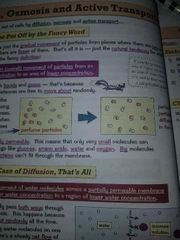
It is the net movement of particles from an area of high to low conc. Moved down the conc gradient. Happens in both liquid and gas that's because these particles and move randomly. Cell membrane are partially permeable. Meaning, only small molecules can move thru like glucose, amino acids, water, oxygen. |
|
|
What is Osmosis? |
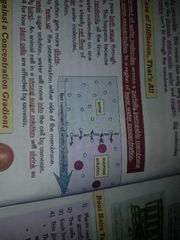
Net movement of water molecules across a partially permeable membrane from high to low. Water molecules pass both ways, because water molecules move randomly. There is a stronger sugar conc where there is less water molecules. If an animal cell was placed in a weak solution water would move into the cell by osmosis. The cell would swell and burst. An animal cell in a stronger solution will shrink as water moves out. |
|
|
What is active transport? |
It is the movement of particles across a membrane against the conc gradient. Low to high. Particles move up thr conc gradient. Process requires energy unlike diffusion which Is a passive process. |
|
|
Factors that affect diffusion: |
Conc gradient- the bigger the difference between conc the faster the rate of diffusion. Membrane surface area: larger SA the faster the rate of diffusion. More particles can pass thru.Temperature: higher temp faster particles move. . Temperature: higher temp faster particles move. |
|
|
Describe an example of diffusion in the lungs: |
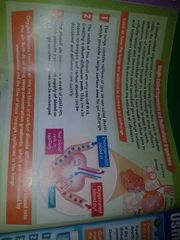
What maximises diffusion? Large surface area Each a alveoli is spherical Large number of alveoli Short diffusion rate.
|
|
|
Surface area to volume ratio: |
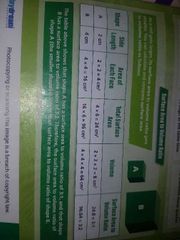
As a cell gets larger is SA gets smaller |
|
|
Name other examples of diffusion in mammals, plant and fish: |
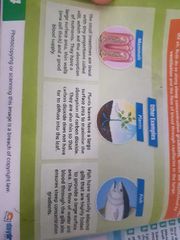
|
|
|
What is osmosis use by in plants and % formula? |
Osmosis is used by plants to absorb water from the soil through the root hair cells. Osmosis can cause tissue to gain or loose mass, calculate change is mass= %change= change in mass/ initial mass ×100 |
|
|
Describe the osmosis practical: |
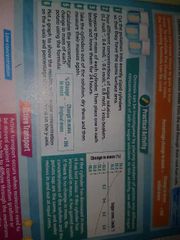
|
|
|
Osmosis in plants: dilute, isotonic, conc sugar solution: |
Dilute- has hight water potential. Plant would be turgid and full of water. Isotonic- same water potential as the inside of cell. Plant maintains its shape. No gain of mass. Conc sugar- very low water potential. Water would move out my osmosis. Plant cell would shrivel and cell membrane and cytoplasm would pull away. This Is called plasmalysed. Becomes flaccid. |
|
|
Osmosis isotonic, dilute and conc sugar in mammals red blood cells: |
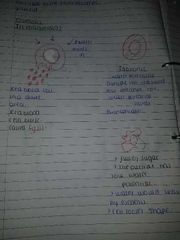
|
|
|
Active transport root hair cell- explain: |
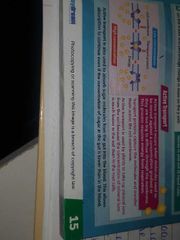
|
|
|
Explain mitosis: |
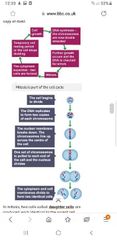
MitosisCells divide when:an organism growsan organism becomes damaged and needs to produce new cellsIt is essential that any new cells produced contain genetic information that is identical to the parent cell. The cell cycleA growing and dividing cell goes through a series of stages called the cell cycle.The first stages of the cell cycle involve cell growth, then synthesis of new DNA, to replicate the original DNA. The single strand of DNA that makes up each chromosome produces an exact copy of itself.Mitosis is part of the cell cycleIn mitosis, two cells called daughter cells are produced, each identical to the parent cell.When looking at cells with a microscope, the length of different stages of the cell cycle can be estimated using the formula: |
|
|
Explain how hotel sperm, muscle and nerve cell are differentiated: |
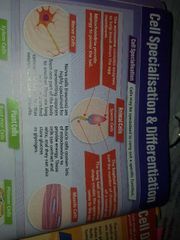
|
|
|
explain how xylem, phloem and root hair cell are differentiated: |
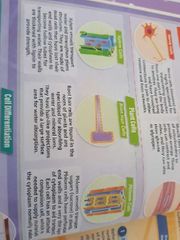
|
|
|
What is cell differentiation? explain in terms of blood cell etc |
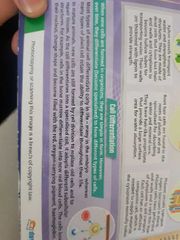
|
|
|
Describe stem cell in embryos, adult and plants: |
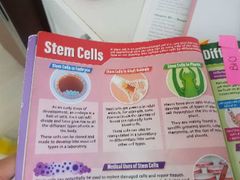
|
|
|
medical uses of plant cells and pros and cons: |
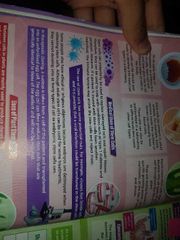
|
|
|
Uses of plants in stem cells |
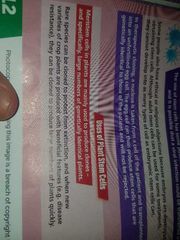
|
|
|
Human circulatory: hoe it works... |
The heart is an organ in the circulatory system. The circulatory system carries oxygen and nutrients to every cell in the body and removes the waste products. The heart pumps blood around the body in a double circulatory system. This means there are two circuits. Mammals require this double system because the metabolic rate is higher and so need a faster system. ● System 1: Deoxygenated blood flows into the right atrium and then into the right ventricle which pumps it to the lungs to undergo gaseous exchange ● System 2: Oxygenated blood flows into the left atrium and then into the left ventricle which pumps oxygenated blood around the body Structure of the heart ● Muscular walls to provide a strong heartbeat ● The muscular wall of the left ventricle is thicker because blood needs to be pumped all around the body rather than just to the lung like the right ventricle. ● 4 chambers that separate the oxygenated blood from the deoxygenated blood: 2 atria above and 2 ventricles below ● Valves to make sure blood does not flow backwards ● Coronary arteries cover the heart to provide its own oxygenated blood supply |
|
|
What is the process of the circulatory system... |
Process: 1. Blood flows into the right atrium through the vena cava, and left atrium through the pulmonary vein. 2. The atria contract forcing the blood into the ventricles. 3. The ventricles then contract, pushing the blood in the right ventricle into the pulmonary artery to be taken to the lungs, and blood in the left ventricle to the aorta to be taken around the body. 4. As this happens, valves close to make sure the blood does not flow backwards. |
|
|
Structures of the blood vessels... veins, capillaries and arteries. |
Arteries carry blood AWAY from the heart ● Layers of muscle in the walls make them strong ● Elastic fibres allow them to stretch ● This helps the vessels withstand the high pressure created by the pumping of the heart Veins carry blood TOWARDS the heart ● The lumen (the actual tube in which blood flows through) is wide to allow the low pressure blood to flow through ● They have valves to ensure the blood flows in the right direction Capillaries allow the blood to flow very close to cells to enable substances to move between them ● One cell thick walls create a short diffusion pathway ● Permeable walls so substances can move across them |
|
|
Structures of the blood: |
Structure of blood Red blood cells: ● Contain haemoglobin: a red protein that combines with oxygen to allow for transport ● No nucleus: to create more space for haemoglobin ● Biconcave shape: to maximise surface area for oxygen to be absorbed ● Flexible: so they can fit through very narrow blood vessels Plasma: ● Plasma is the liquid which carries all of the components of blood, such as blood cells, platelets, amino acids, urea etc. ● Plasma is mainly made up of water and many substances that need to be transported around the body, e.g. carbon dioxide, urea, are water-soluble |
|
|
What is transpiration? |
Transpiration is the loss of water of water vapour from the leaves and stems of the plant. It is a consequence of gaseous exchange, as the stomata are open so that this can occur. ● Water also evaporates at the open stomata ● As water molecules are attracted to each other, when some molecules leave the plant the rest are pulled up through the xylem ● This results in more water being taken up from the soil resulting in a continuous transpiration stream through the plant |
|
|
Explain what the xylem vessel does? |
Xylem: Water travels up xylem from the roots into the leaves of the plant to replace the water that has been lost due to transpiration. Xylem is adapted in many ways: ● A chemical called lignin is deposited which causes the cells to die. ● These cells then become hollow and join end-to-end to form a continuous tube for water and mineral ions to travel through from the roots ● Water molecules are attracted to each other by hydrogen bonding - creating a continuous column of water up the plant ● The water evaporates from the leaves of the plant, creating the transpiration stream. ● Lignin strengthens the plant to help it withstand the pressure of the water movement ● Lignin contains bordered pits, which are holes to allow specific areas for water and therefore minerals to enter the plant |
|
|
Factors that affect water uptake: |
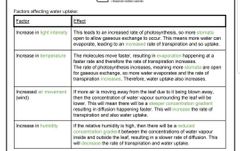
|
|
|
What can a potometer be used for? |
A potometer can be used to investigate how these factors affect water uptake. It is set up underwater to remove air bubbles in the xylem so that there is a continuous stream of water and the system is made airtight, apart from a singular bubble of air. The distance this air bubble in the capillary tube moves over time is measured. If it moves faster then it means that there is a greater rate of water uptake and therefore rate of transpiration. An environmental condition, such as light intensity, is changed each time the experiment is run in order to see how it affects the plant. |
|
|
What is translocation? |
Translocation is the movement of food substances made in the leaves up or down the phloem. |
|
|
What is phloem used for? |
Phloem adaptations: ● Found in the roots, stems and leaves ● Elongated cells with holes in the cell walls (the end walls are called sieve plates) ● Many organelles from the cells are removed so cell sap can move through. ○ However, there are many mitochondria in companion cells which provide the energy the cells require ● Food substances can be moved in both directions (translocation), from the leaves where they are made for use, or from storage (underground) to parts of the plant that need it. |

